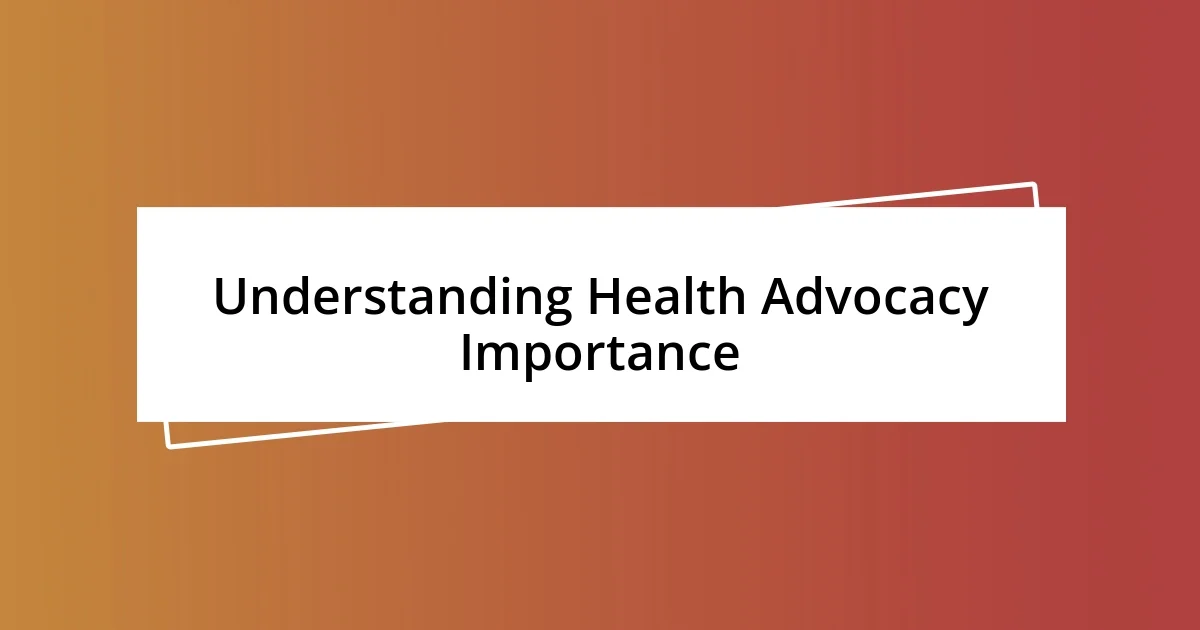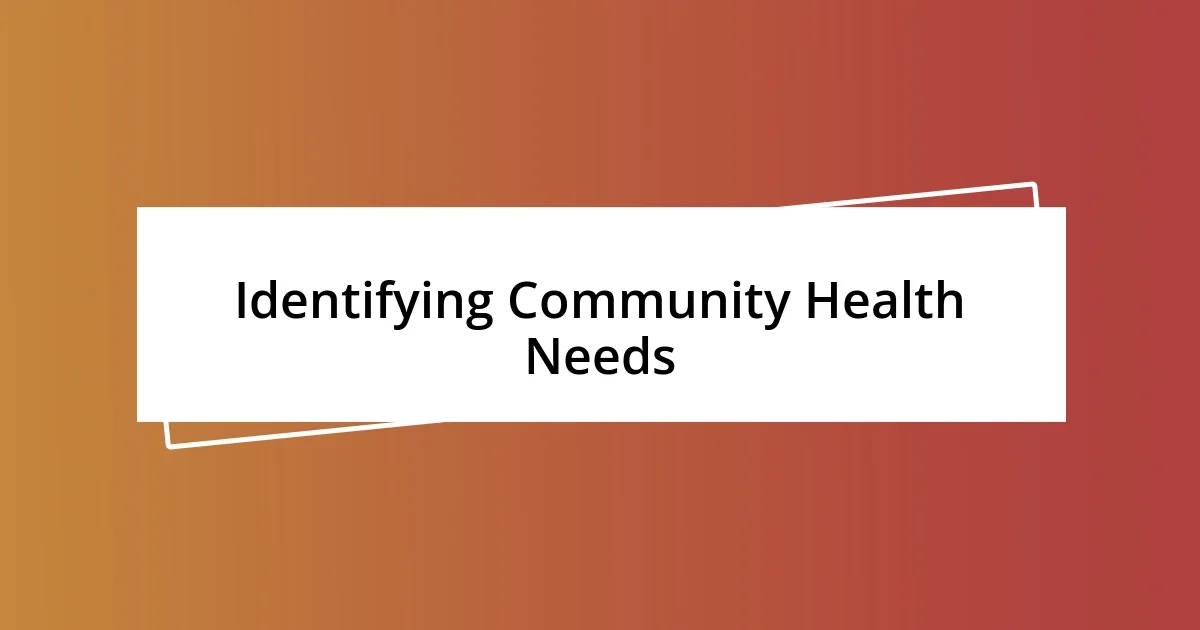Key takeaways:
- Health advocacy plays a crucial role in empowering individuals, bridging gaps in healthcare access, and fostering community support.
- Building meaningful relationships with stakeholders through active listening and acknowledgment of their efforts enhances advocacy effectiveness.
- Measuring the impact of advocacy goes beyond data; personal stories and long-term changes in community behavior reflect the true success of initiatives.

Understanding Health Advocacy Importance
Health advocacy is not just a buzzword; it’s a vital part of our healthcare system that can significantly impact individual and community well-being. I remember a particular incident while volunteering at a local clinic when a patient felt overwhelmed by their diagnosis. By advocating for their needs and connecting them with resources, I saw firsthand how empowerment could lead to better decision-making in their health journey. Isn’t it amazing how a little support can transform someone’s experience?
When we talk about the importance of health advocacy, we must recognize its role in bridging gaps in access to care. Picture someone who faces language barriers or financial challenges; their ability to navigate the healthcare system can be daunting. Advocating for these individuals feels like a calling for me, as I believe everyone deserves a fair shot at quality care. Have you ever considered how your voice can uplift someone in need?
Moreover, health advocacy fosters a sense of community and shared responsibility. During a recent health fair, I witnessed a group of individuals come together to tackle a common health issue, sharing their stories and resources. It struck me that advocacy is not just about voicing concerns; it’s about building a supportive network. How powerful is that? Together, we can create a ripple effect of knowledge and understanding that benefits everyone.

Identifying Community Health Needs
Identifying the health needs of a community often feels like piecing together a puzzle. I recall attending a town hall meeting where residents voiced their struggles with chronic illnesses. It was eye-opening to hear how so many were dealing with the same challenges yet had no idea they could band together to advocate for better resources. By actively listening to their concerns, I realized the importance of ensuring everyone has a voice in identifying these needs.
To effectively identify community health needs, consider the following approaches:
- Conduct surveys to gather data on health concerns and access barriers.
- Engage with local organizations to understand the demographics and specific issues facing their populations.
- Organize focus groups or town hall discussions to encourage open dialogue among community members.
- Analyze health statistics and trends that highlight prevalent health challenges.
- Foster relationships with healthcare professionals to gain insights from those who serve the community regularly.
Each of these steps allows for a deeper understanding of the community’s unique health landscape, paving the way for tailored advocacy efforts.

Building Relationships with Stakeholders
Building meaningful relationships with stakeholders is at the core of effective health advocacy. I recall my first meeting with a local health department, where I was nervous but excited. As I shared my ideas on improving outreach, I noticed how the officials responded positively when I acknowledged their existing efforts. I learned that recognizing their hard work built rapport and set the stage for more impactful discussions. It felt rewarding to establish that foundation.
Engaging stakeholders requires more than just presenting facts; it’s about genuine connection. I once attended a community health forum, where I mingled with various contributors passionate about public health. Instead of launching into presenting my agenda, I chose to listen deeply to their experiences. This approach not only informed my understanding but also fostered a sense of belonging. How often do we take the time to truly listen? Building on those insights made my advocacy initiatives resonate more profoundly.
Trust takes time to develop, but it’s worth the investment. In my experience, follow-up meetings helped keep the communication channels open. I remember sending a simple thank-you note after one particularly fruitful gathering. That gesture was more than polite; it reinforced our shared commitment to health advocacy. Trust doesn’t just happen; it’s cultivated through consistent and genuine interactions.
| Stakeholder Engagement Strategies | Description |
|---|---|
| Active Listening | Engaging with stakeholders by truly understanding their perspectives and experiences. |
| Follow-up Communication | Maintaining relationships through consistent and meaningful messages post-meeting. |
| Acknowledgment of Efforts | Recognizing the work and contributions of stakeholders to build rapport. |
| Collaborative Initiatives | Working together on projects to foster a sense of partnership and shared responsibility. |

Training Others in Advocacy Skills
Training others in advocacy skills is a transformative journey for both the trainer and the trainees. I vividly remember a workshop I led where I introduced participants to the art of storytelling in advocacy. As we explored real-life narratives, I noticed how their eyes lit up with understanding. It became clear that sharing personal experiences not only humanizes the issue but also empowers others to find their voice. Isn’t it amazing how a simple story can catalyze meaningful change?
One pivotal moment was when a participant shared her story of navigating the healthcare system for a loved one. The room fell silent as we absorbed her challenges, and I could feel the weight of the emotions reverberating through us all. In that moment, I realized that advocacy training isn’t just about imparting skills; it’s also about creating a safe space for vulnerability. After the session, several attendees expressed how empowered they felt to speak up about their own experiences, which really highlighted the community in advocacy.
To ensure these skills stick, I always emphasize the importance of practice. I organized role-playing exercises where we simulated advocacy situations, such as meeting with policymakers. Watching participants step into their future roles was both exhilarating and humbling. The inquiries they posed were insightful, and I couldn’t help but wonder, how often do we give ourselves permission to practice and fail in a supportive environment? By fostering this mindset, we not only build skills but also confidence to advocate effectively.

Creating Effective Health Campaigns
Creating effective health campaigns involves a blend of creativity, clarity, and connection. I remember working on a campaign focused on mental health awareness, where I brainstormed ideas with a diverse group of advocates. Instead of diving straight into statistics, we focused on designing relatable stories and visuals that resonated with our audience. It was thrilling to watch a simple concept evolve into a campaign that felt personal and approachable.
Once, during the development phase, we conducted a survey within the community to understand their perceptions of mental health. The results were eye-opening, revealing fears and misconceptions that shaped their attitudes. Isn’t it fascinating how data can transform our approach? Using these insights, we crafted messages that addressed those concerns directly, making our campaign not just informative but truly relevant to people’s lives.
I’ve also found that collaboration can often spark innovation. For one event, we teamed up with local artists to create a mural that depicted various mental health themes. Watching community members engage with that art was touching; it became a conversation starter. I reflected on how art can convey complicated emotions, bringing people together in a way that words sometimes can’t. How often do we think outside conventional methods to foster participation? By embracing these unique strategies, we not only raise awareness but also create a shared sense of ownership in health advocacy.

Measuring Impact of Advocacy Efforts
Measuring the impact of advocacy efforts can sometimes feel like trying to catch smoke with your bare hands. I recall a project where we tried to quantify our campaign’s success by tracking engagement through social media interactions and attendance at advocacy events. Initially, the numbers seemed encouraging, but it was the heartfelt letters and messages I received from community members that truly highlighted our impact. Isn’t it extraordinary how personal stories can illustrate the change we often overlook in cold, hard data?
Another layer to measuring impact is the long-term changes in community behavior and policy. I think back to a health initiative aimed at increasing screening rates for a prevalent condition. Months after the program ended, local health centers reported a significant uptick in screening appointments – a tangible testament to our advocacy work. But what did that really mean for individuals? When one participant approached me, sharing how their early detection led to proactive care, I realized that the true measure of our success lies not just in numbers but in the lives we touch.
Evaluating advocacy efforts also involves gathering qualitative feedback to understand both the highs and lows of our initiatives. I remember conducting interviews with community members after a health fair we organized. Many offered constructive criticism, which initially stung, but those insights became gold when refining future projects. How often do we embrace feedback as a tool for growth instead of viewing it as a setback? By approaching evaluation with an open heart, we empower ourselves to continue evolving as advocates, striving to make our voices even louder in the fight for health equity.














